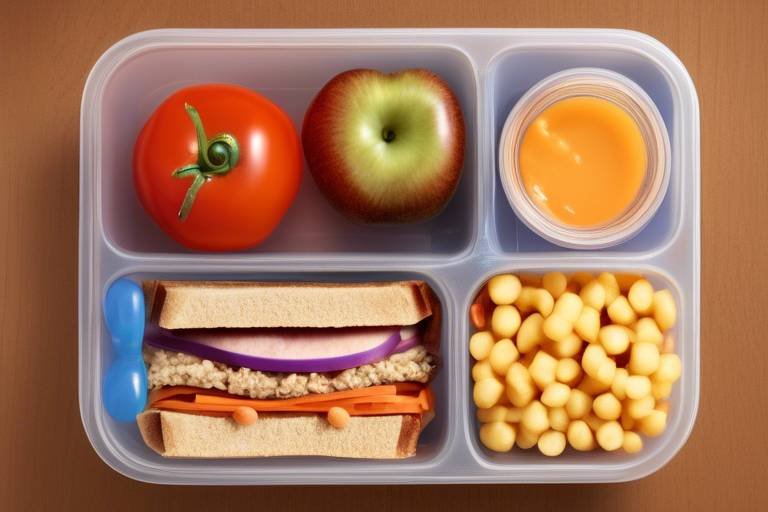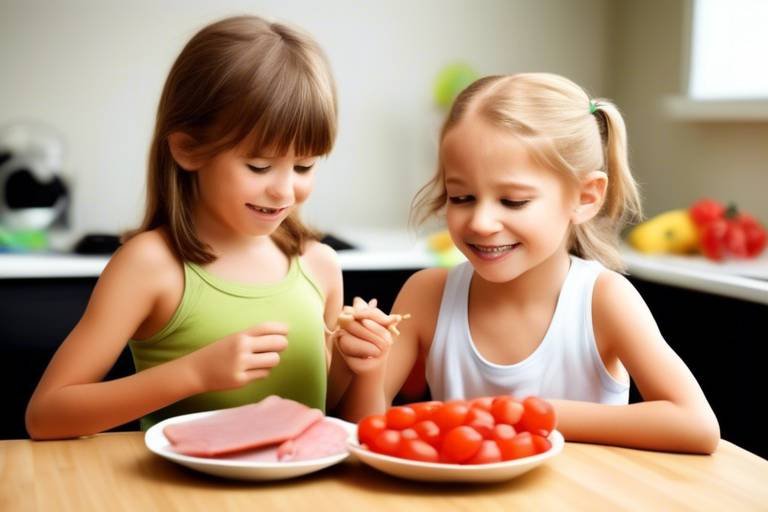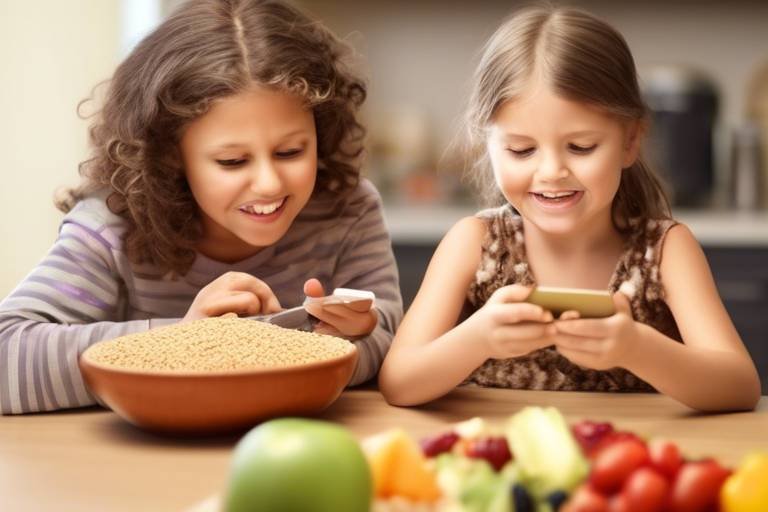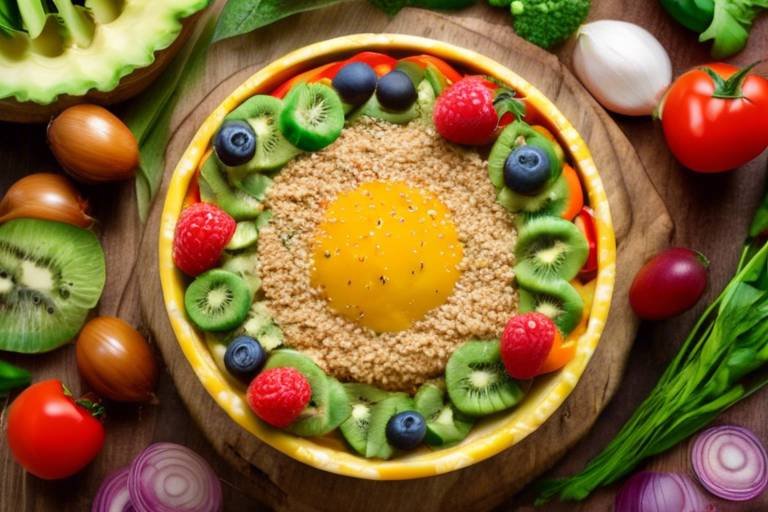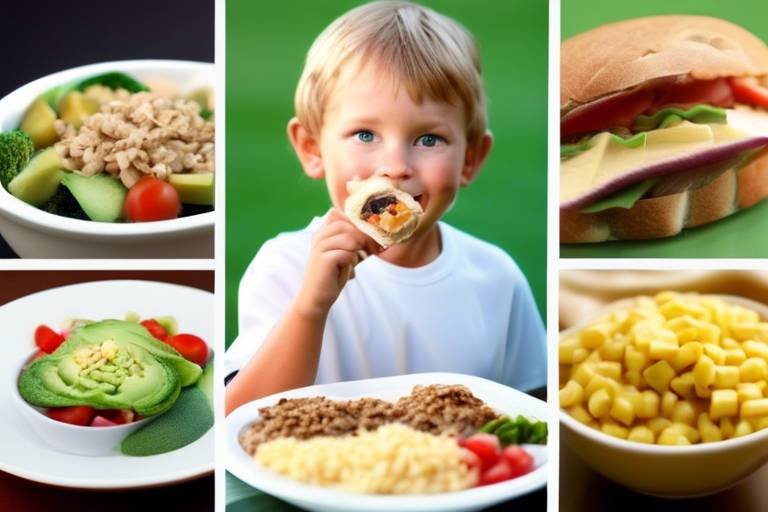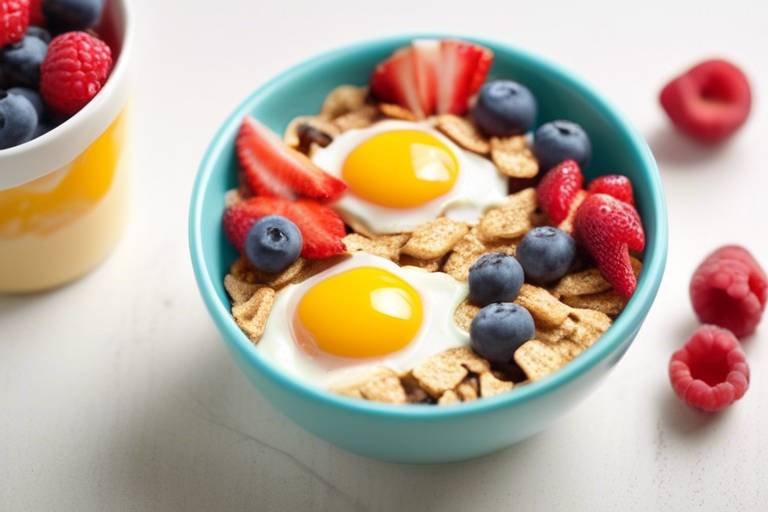How to Make Your Child's School Lunch More Nutritious
In today’s fast-paced world, ensuring that our children receive the right nutrition can feel like a daunting task. With busy mornings and the temptation of quick, unhealthy options, it’s easy to overlook the importance of a well-balanced school lunch. But fear not! This article explores practical strategies for enhancing the nutritional value of your child's school lunch, ensuring they receive the essential vitamins and minerals needed for growth and development. By making small changes and incorporating nutritious foods, you can transform lunchtime into an opportunity for your child to refuel and thrive.
Recognizing the specific dietary requirements of children is crucial. Children are not just mini-adults; their bodies and brains are rapidly developing, which means they need a variety of nutrients to support this growth. Essential nutrients include proteins, carbohydrates, fats, vitamins, and minerals. For instance, proteins are vital for muscle growth, while carbohydrates provide the energy needed for a busy school day. Healthy fats support brain development, and vitamins and minerals are essential for a robust immune system. Understanding these needs can help you make informed decisions about what to pack in your child's lunch.
Whole foods are packed with nutrients that are essential for your child's health. Rather than reaching for processed snacks, consider filling your child's lunchbox with fruits, vegetables, whole grains, and lean proteins. Whole foods not only provide more vitamins and minerals but also contain fiber, which aids digestion and keeps kids feeling full longer. For example, instead of white bread, opt for whole-grain bread, which is richer in nutrients and can help maintain energy levels throughout the school day.
Fruits are a vital part of a nutritious lunch. They are not only delicious but also packed with essential vitamins and antioxidants. When selecting fruits for your child, consider seasonal options, as they are often fresher and more flavorful. Some popular choices include apples, bananas, berries, and oranges. To make fruits more appealing, try cutting them into fun shapes or pairing them with a tasty dip. This small effort can make a big difference in encouraging your child to enjoy their fruits!
Combining different fruits can enhance both taste and nutrition. For instance, you can create a colorful fruit salad using a mix of strawberries, blueberries, and kiwi. Another fun idea is to blend fruits into smoothies, which can be a delicious and nutritious option for lunch. You can also make fruit skewers by threading pieces of fruit onto a stick, turning snack time into a fun activity. The more visually appealing the food, the more likely your child will want to eat it!
Dips can make fruits more enticing and enjoyable. Healthy dips like yogurt or nut butter not only add flavor but also provide additional nutrients. For example, a simple yogurt dip can be made by mixing Greek yogurt with a bit of honey and cinnamon, creating a delicious accompaniment for apple slices. Nut butter, on the other hand, is rich in healthy fats and protein, making it a perfect match for bananas or celery sticks. These dips can transform ordinary fruits into a delightful treat!
Snacks are an essential part of a school lunch, but many kids gravitate towards chips and sugary treats. Instead, consider offering nutritious snack alternatives that promote better eating habits. Options like hummus and veggie sticks, whole-grain crackers, or yogurt with granola can provide the crunch and satisfaction kids crave without the excess sugar and unhealthy fats. By introducing these healthier snack choices, you can help your child develop a taste for more nutritious foods.
Sandwiches can be a fantastic source of nutrition if made thoughtfully. Start by choosing whole-grain breads, which are higher in fiber and nutrients compared to white bread. Next, focus on healthy fillings that provide a balance of protein, fats, and carbohydrates. For instance, a turkey and avocado sandwich on whole-grain bread not only tastes great but also delivers essential nutrients that are beneficial for your child’s growth.
Selecting the right protein is key to creating a nutritious sandwich. Healthy protein options like turkey, chicken, or even plant-based alternatives such as hummus or beans can enhance the nutritional value of sandwiches. These proteins provide the energy and building blocks necessary for your child's development. Don't shy away from experimenting with different proteins to find what your child enjoys the most!
Adding vegetables to sandwiches boosts their nutritional content significantly. Incorporating colorful veggies like spinach, tomatoes, and bell peppers not only enhances the flavor but also adds vitamins and minerals. Get creative by making veggie-packed spreads or using sliced cucumbers as a crunchy layer. The key is to make vegetables fun and appealing so that your child is excited to eat them!
- What are some quick and easy lunch ideas for busy mornings? Consider wraps, sandwiches, or bento boxes that can be prepared the night before.
- How can I encourage my child to try new foods? Involve them in the preparation process and make it a fun family activity.
- Are there any foods to avoid in school lunches? Try to limit sugary snacks, processed foods, and anything high in sodium.

Understanding Nutritional Needs
When it comes to our children, we all want the best for them, especially when it comes to their health and nutrition. Understanding their specific dietary needs is crucial for ensuring they grow strong and healthy. Children, much like little engines, require a balanced mix of fuel to operate at their best. This fuel comes in the form of essential nutrients, which can be categorized into five main groups: proteins, carbohydrates, fats, vitamins, and minerals.
Let's break it down a bit. Proteins are the building blocks of growth. They help in building muscles, repairing tissues, and producing enzymes and hormones. Think of proteins as the construction workers of the body, tirelessly working to build and maintain everything from muscles to skin. Good sources of protein include lean meats, eggs, dairy products, and plant-based options like beans and lentils.
Next up, we have carbohydrates, which are the primary source of energy for children. Imagine carbohydrates as the gasoline that fuels their daily activities, from running around during recess to focusing in the classroom. Whole grains, fruits, and vegetables are excellent sources of complex carbohydrates that provide sustained energy without the crash that comes from sugary snacks.
Now, let’s not forget about fats. While they often get a bad rap, healthy fats are essential for brain development and overall health. Think of fats as the protective gear that keeps everything running smoothly. Avocados, nuts, seeds, and fish are fantastic sources of healthy fats that can easily be incorporated into school lunches.
Vitamins and minerals are like the tiny superheroes of nutrition. They support various bodily functions, from boosting the immune system to aiding in the absorption of nutrients. For example, vitamin C found in fruits helps heal wounds, while calcium from dairy strengthens bones. To ensure your child gets a variety of these nutrients, aim to include a colorful array of fruits and vegetables in their lunchbox.
To sum it up, a well-rounded school lunch should aim to include:
- Proteins: Lean meats, eggs, dairy, beans
- Carbohydrates: Whole grains, fruits, vegetables
- Fats: Avocados, nuts, seeds, fish
- Vitamins and Minerals: A colorful mix of fruits and vegetables
By understanding these nutritional needs, you can make informed choices that will not only satisfy your child’s taste buds but also support their growth and development. Remember, a nutritious lunch is like a well-oiled machine, ensuring that your child has the energy and nutrients they need to thrive throughout the day.

Incorporating Whole Foods
When it comes to your child's lunch, whole foods should be your best friend. These foods are not only packed with essential nutrients, but they also provide a variety of flavors and textures that can make lunchtime exciting! Think about it: would you rather munch on a bland, processed snack or enjoy a vibrant, crunchy carrot stick dipped in hummus? Whole foods are the way to go, and incorporating them into your child's lunch can significantly enhance their nutritional intake.
Whole foods include fruits, vegetables, whole grains, and lean proteins. By focusing on these items, you can ensure that your child is getting a balanced diet. For example, instead of reaching for a sugary granola bar, why not pack a handful of whole grain crackers with some cheese? This simple swap not only boosts the nutritional value but also keeps them feeling full longer. Whole foods are like the superheroes of nutrition; they come loaded with vitamins, minerals, and fiber that your child needs to thrive.
One of the easiest ways to incorporate whole foods is to make them the star of the show in your lunchbox. Start with fresh fruits and vegetables. They are not only nutritious but also colorful and appealing. You can create a fun lunch by including a rainbow of produce. For instance, pack some cherry tomatoes, cucumber slices, and bell pepper strips alongside a small container of hummus or yogurt for dipping. This not only makes the meal visually appealing but also encourages your child to try a variety of flavors.
Whole grains are another fantastic addition. Swap out white bread for whole grain bread or wraps, and choose brown rice or quinoa as a base for salads. These grains are rich in fiber and nutrients, fueling your child with the energy they need for a busy school day. You might also consider making homemade granola with oats, nuts, and dried fruits—it's a great way to control the ingredients and avoid added sugars found in many store-bought options.
Protein is essential for growth and development, and incorporating lean proteins like chicken, turkey, or even plant-based options such as beans and lentils can make a significant difference. For example, a turkey and avocado wrap on whole grain tortilla is not only delicious but also packed with nutrients. You can also try adding some nuts or seeds to salads or yogurt for an extra protein punch.
Here’s a quick comparison of some common lunch options to illustrate the benefits of whole foods:
| Lunch Option | Nutritional Value | Whole Food Alternative | Nutritional Value |
|---|---|---|---|
| Processed Cheese Sandwich | High in sodium, low in nutrients | Whole Grain Turkey Sandwich | High in protein, fiber, and vitamins |
| Potato Chips | High in unhealthy fats and calories | Carrot Sticks with Hummus | Low in calories, high in vitamins and fiber |
| Fruit Snacks | High in sugar, low in fiber | Fresh Berries | Rich in antioxidants and vitamins |
By making these small changes and focusing on whole foods, you can transform your child's lunch into a powerhouse of nutrition. Remember, it's all about balance and variety. The more colorful and diverse their lunch is, the more likely they are to enjoy eating it while getting the nutrients they need. So, roll up your sleeves, get creative, and watch your child thrive with the power of whole foods!
Q: What are whole foods?
A: Whole foods are foods that are minimally processed and are free from artificial ingredients and preservatives. They include fruits, vegetables, whole grains, nuts, seeds, and lean proteins.
Q: How can I make whole foods appealing to my child?
A: You can make whole foods appealing by presenting them in fun and creative ways, such as fruit skewers, colorful salads, or by incorporating dips like hummus or yogurt.
Q: Are whole foods more expensive than processed foods?
A: While some whole foods can be pricier, many are affordable, especially when bought in bulk or in season. The health benefits they provide often outweigh the cost.

Choosing the Right Fruits
When it comes to packing a nutritious school lunch, choosing the right fruits can make all the difference. Fruits are not just colorful additions to your child's meal; they are powerhouses of essential vitamins, minerals, and fiber that contribute to overall health and well-being. But how do you select the best fruits that not only provide nutrition but also appeal to your child's taste buds? Let's dive into some delicious options!
First off, it’s important to consider seasonal fruits. Not only are they typically fresher and tastier, but they also tend to be more affordable. For example, in the summer, you might find juicy watermelons, sweet peaches, and vibrant berries that can make any lunchbox pop with flavor. In the fall, think about crisp apples and succulent pears. Choosing fruits that are in season can also be a fun way to teach your child about nature's cycles and encourage them to try new things.
Another key aspect to consider is the presentation. Let’s face it, kids are often more inclined to eat something that looks appealing. You can make fruits visually exciting by cutting them into fun shapes or arranging them in a colorful pattern. For instance, a rainbow fruit salad can be a feast for the eyes as well as the stomach! Combine strawberries, oranges, kiwis, blueberries, and grapes to create a vibrant mix that can brighten up any lunchbox.
Moreover, pairing fruits with healthy dips can transform the eating experience. Think of yogurt or nut butter as the perfect companions for apple slices or banana halves. Not only do these dips add flavor, but they also provide an extra boost of protein and healthy fats. This combination can keep your child feeling full and satisfied throughout the school day.
Finally, don't shy away from incorporating dried fruits into the mix. They are convenient and can be a great source of energy, especially during busy school days. However, be cautious about added sugars; choose options that are naturally sweetened or unsweetened. Dried fruits like apricots, raisins, and cranberries can be a delightful addition to trail mixes or as a topping for yogurt.
In summary, selecting the right fruits for your child's school lunch involves a mix of seasonal choices, creative presentation, tasty pairings, and occasional dried options. By making fruits a fun and appealing part of their meal, you're not just enhancing their lunch; you're also fostering a lifelong love for healthy eating!
- What are the best fruits to pack for a school lunch? Seasonal fruits such as apples, bananas, oranges, and berries are great choices.
- How can I make fruits more appealing to my child? Try cutting them into fun shapes, creating fruit skewers, or pairing them with dips like yogurt or nut butter.
- Are dried fruits healthy? Yes, but be sure to choose options without added sugars to keep them nutritious.

Creative Fruit Combinations
When it comes to making your child's school lunch exciting and nutritious, can be a game changer. Kids are often more inclined to eat healthy foods when they are presented in a fun and visually appealing way. Think of fruits as the vibrant colors on a painter's palette; when mixed creatively, they can create a masterpiece of flavors and textures that your child will love. So, how can you turn ordinary fruits into extraordinary snacks? Let's explore some delightful combinations!
One fantastic idea is to create a fruit salad that’s not just a mix of chopped fruits but a colorful explosion of flavors. You can combine seasonal fruits like juicy strawberries, sweet mangoes, and refreshing watermelon. To make it even more enticing, consider adding a splash of lime juice and a sprinkle of mint for a zesty kick. This not only enhances the flavor but also adds a touch of sophistication that kids might find appealing.
Another fun option is to whip up some fruit smoothies. These can be a great way to sneak in additional nutrients without your child even noticing. Blend together a banana, a handful of spinach (yes, you read that right!), some frozen berries, and a splash of yogurt or milk. The vibrant colors and creamy texture will make your child think they’re indulging in a milkshake while you know they’re getting a powerhouse of vitamins. You can even pack these smoothies in a thermos for school!
If you're looking for a portable snack, how about fruit skewers? Simply take some skewers and thread on pieces of different fruits like pineapple, grapes, and kiwi. Not only do they look fun, but they also make eating fruit feel like a special treat. You could even let your child help with this task, allowing them to choose their favorite fruits and assemble their own skewers. This hands-on approach can make them more excited about eating healthy!
To elevate the fruit experience, consider incorporating some dips. Dips can transform the way kids enjoy their fruits. For instance, a simple yogurt dip made with Greek yogurt and a drizzle of honey can make apples and strawberries irresistible. Alternatively, nut butter can be a fantastic pairing with bananas or celery sticks. Dipping adds an interactive element to eating fruits, making it more engaging for kids.
In summary, by mixing and matching fruits in creative ways, you can turn a simple school lunch into a colorful and nutritious feast. Whether it’s through fruit salads, smoothies, skewers, or fun dips, the possibilities are endless. Remember, the goal is to make fruits not just healthy but also a delightful experience that your child looks forward to each day!
Q: How can I encourage my child to try new fruits?
A: One effective way is to involve them in the selection process. Take them to the grocery store or farmers' market and let them pick out a fruit they’ve never tried before. You can also try presenting the fruit in a fun way, like in a smoothie or as part of a colorful fruit salad.
Q: What are some fruits that are easy to pack for school lunches?
A: Some great options include apples, bananas, grapes, and mandarin oranges. These fruits are not only easy to pack but also require minimal preparation. Just wash them, and they’re good to go!
Q: Are there any fruits that should be avoided in school lunches?
A: While most fruits are healthy, it's best to avoid those that are overly messy or require refrigeration, like cut melons or berries that can spoil quickly. Opt for sturdier fruits that can withstand being in a lunchbox for a few hours.

Incorporating Dips
When it comes to making school lunches more appealing, dips can be a game changer! Kids often love to dip their food, and incorporating healthy dips can not only enhance the flavor but also boost the nutritional profile of their meals. Think of dips as the secret sauce that can turn ordinary fruits and veggies into exciting snacks. Imagine your child munching on carrot sticks, but instead of just plain old carrots, they’re dunking them into a creamy, delicious yogurt dip. Sounds much more fun, right?
There are countless options for dips that can complement fruits and vegetables, making them irresistible for your little ones. For instance, a simple yogurt dip can be made by mixing plain yogurt with a splash of honey and a sprinkle of cinnamon. This not only adds sweetness but also provides probiotics that are beneficial for gut health. Similarly, nut butter is another fantastic choice; it’s rich in healthy fats and proteins. Just imagine apple slices dipped in creamy almond butter—what a delightful combination!
To give you a better idea of how to incorporate dips into your child’s lunch, here are a few delicious recipes that are both easy to make and nutritious:
| Dip Type | Ingredients | Benefits |
|---|---|---|
| Yogurt Dip | 1 cup plain yogurt, 1 tbsp honey, 1 tsp cinnamon | Rich in probiotics, calcium, and protein |
| Nut Butter Dip | 1 cup nut butter (peanut, almond, etc.), 1 banana (mashed) | High in healthy fats and potassium |
| Hummus | 1 can chickpeas, 2 tbsp tahini, 1 clove garlic, lemon juice | Great source of protein and fiber |
These dips can be made in advance and stored in small containers, making them easy to pack for school. Not only do they add flavor, but they also encourage kids to eat more fruits and vegetables, which can sometimes be a challenge. You can even set up a fun “dip station” at home where children can choose their favorite dip to pair with different fruits and veggies. This not only makes lunch more interactive but also teaches them about making healthier choices.
So, why not give dips a try in your child’s next school lunch? You’ll be surprised at how much more they enjoy their meals when they have something delicious to dunk their snacks into!
Q: Are dips suitable for all age groups?
A: Yes, dips can be enjoyed by children of all ages, but be sure to choose ingredients that are appropriate for their age and chewing abilities.
Q: How can I make dips more appealing to my kids?
A: Get creative! Use fun containers, colorful vegetables, and involve your kids in the dipping process. Making it a fun activity can encourage them to try new things.
Q: Can I store dips for later use?
A: Absolutely! Most dips can be stored in the refrigerator for a few days. Just make sure to keep them in airtight containers to maintain freshness.

Healthy Snack Alternatives
When it comes to packing a school lunch, snacks play a crucial role in keeping your child energized and focused throughout the day. However, many traditional snack options like chips and sugary treats can lead to energy crashes and unhealthy eating habits. So, what can you do to ensure your child enjoys delicious snacks that are also nutritious? The key is to explore a variety of healthy alternatives that are both satisfying and good for their growing bodies.
One excellent way to start is by incorporating whole foods into their snack routine. Instead of reaching for that bag of chips, consider offering snacks like fresh fruits, vegetable sticks, and whole grain options. These foods not only provide essential vitamins and minerals but also keep kids full longer. For example, pairing apple slices with peanut butter or hummus with carrot sticks can create a balanced snack that’s rich in protein and fiber.
Let’s dive into some that can easily replace those less nutritious options:
- Greek Yogurt with Honey: A creamy and delicious option that’s packed with protein. You can have your child add some fresh berries or granola for extra flavor and crunch.
- Trail Mix: Make your own mix with nuts, seeds, and a few dark chocolate chips or dried fruits. This combination provides healthy fats, fiber, and antioxidants.
- Popcorn: Air-popped popcorn is a whole grain snack that can be seasoned with a pinch of salt or nutritional yeast for a cheesy flavor without the calories.
- Rice Cakes: These can be topped with almond butter or avocado for a tasty and filling snack that’s also gluten-free.
It’s important to get creative and involve your child in the snack-making process. When kids help choose or prepare their snacks, they’re more likely to eat them. You could also try making snack time a fun experience by presenting the snacks in exciting ways. For example, you might create a colorful snack platter with an assortment of fruits, vegetables, and dips. This not only looks appealing but also allows your child to explore different flavors and textures.
Another great strategy is to keep healthy snacks readily available at home. Stock your pantry and fridge with nutritious options so that when your child feels hungry, they can easily grab something wholesome. You could even set up a dedicated “snack station” where they can choose from a variety of healthy snacks. This empowers them to make better choices and fosters independence.
Lastly, don’t forget to talk to your child about the importance of nutrition. Teaching them why certain foods are better than others can encourage them to make healthier choices on their own. After all, understanding the benefits of healthy eating can be a powerful motivator for kids.
1. What are some quick and easy healthy snacks for school?
Some quick options include Greek yogurt, fruit cups, cheese sticks, and homemade granola bars. These snacks are nutritious and can be prepared in advance.
2. How can I make healthy snacks more appealing to my child?
Presentation matters! Use colorful plates, cut fruits into fun shapes, or create a “snack rainbow” with various fruits and veggies to make them visually appealing.
3. Are store-bought healthy snacks a good option?
Yes, but it’s important to read labels. Look for snacks with minimal ingredients, no added sugars, and whole food components. Brands that focus on natural ingredients can be a great choice.
4. Can I involve my child in making snacks?
Absolutely! Involving your child in snack preparation can make them more excited about eating healthy. Simple tasks like mixing ingredients or arranging snacks can be fun and educational.

Making Balanced Sandwiches
Sandwiches can be a fantastic way to pack in nutrients while being easy to prepare and fun to eat. The key to a nutritious sandwich lies in the ingredients you choose. By selecting whole-grain breads and incorporating a variety of healthy fillings, you can create a balanced meal that your child will love. Whole-grain bread not only provides essential fiber but also keeps your child feeling full longer, which is crucial for maintaining energy levels throughout the school day.
When it comes to fillings, think outside the box! Instead of the usual processed meats, consider using lean proteins like turkey, grilled chicken, or even plant-based options such as hummus or bean spreads. These choices are not only healthier but also add different textures and flavors to the sandwich. You might be surprised at how much your child enjoys a sandwich made with a spread of avocado and topped with sliced turkey or a colorful veggie mix.
Another important aspect of making balanced sandwiches is the inclusion of vegetables. Adding a variety of veggies can greatly enhance the nutritional profile of the sandwich. Some great options include:
- Spinach or kale for a leafy crunch
- Cucumbers for a refreshing bite
- Tomatoes for juiciness and flavor
- Bell peppers for sweetness and color
Not only do these vegetables add essential vitamins and minerals, but they also make the sandwich visually appealing. You can even get creative by using cookie cutters to shape the bread or the vegetables into fun forms that your child will be excited to eat. This little trick can turn an ordinary sandwich into a delightful experience!
To make the sandwiches even more enticing, consider adding a spread that complements the flavors. Options like hummus, mustard, or a light cream cheese can add moisture and flavor without the extra calories and unhealthy fats found in mayonnaise. Plus, spreads can serve as a great way to introduce new tastes to your child’s palate.
Ultimately, the goal is to create sandwiches that are not only nutritious but also enjoyable. Encourage your child to help in the sandwich-making process; they might be more inclined to eat what they’ve helped to create. Ask them about their favorite ingredients and let them choose what goes into their lunch. This involvement can foster a positive attitude towards healthy eating, setting the foundation for lifelong healthy habits.
Q: What types of bread are best for making healthy sandwiches?
A: Whole-grain breads are the best choice as they are higher in fiber and nutrients compared to white bread. Look for options that list whole grains as the first ingredient.
Q: Can I prepare sandwiches the night before?
A: Absolutely! Preparing sandwiches the night before can save time in the morning. Just be sure to store them in an airtight container to keep them fresh. Consider adding ingredients like lettuce or tomatoes just before serving to prevent sogginess.
Q: How can I make sandwiches more appealing to my child?
A: Use fun shapes, colorful ingredients, and let your child participate in the preparation. Adding dips or spreads can also enhance the taste and make it more exciting!
Q: Are wraps a healthier alternative to sandwiches?
A: Wraps can be a healthy alternative if made with whole-grain tortillas and filled with nutritious ingredients. Just be mindful of portion sizes, as it can be easy to overfill them.

Protein Choices for Sandwiches
When it comes to crafting the perfect sandwich for your child’s school lunch, the choice of protein is absolutely crucial. Protein not only fuels your child's energy levels but also plays a vital role in their growth and development. Think of it as the building blocks for their little bodies! To make sure your child gets a nutritious boost, consider a variety of protein options that are both healthy and appealing. Here are some great choices:
- Turkey: Lean turkey is a fantastic option that is low in fat and high in protein. It’s also packed with essential nutrients like zinc and B vitamins, which are important for energy and immune function.
- Chicken: Grilled or roasted chicken breast can be a delicious addition. It’s versatile and can be seasoned in numerous ways to keep things interesting. Plus, it's a great source of lean protein!
- Plant-Based Proteins: For families leaning towards vegetarian options, consider using hummus, black beans, or chickpeas. They are not only protein-packed but also provide fiber, which is essential for digestion.
- Tuna or Salmon: Canned tuna or salmon can be a quick and easy protein source. They are rich in omega-3 fatty acids, which are beneficial for brain health. Just be mindful of mercury levels and choose options that are sustainably sourced.
- Egg Salad: Egg salad made with Greek yogurt instead of mayonnaise can be a creamy and tasty protein choice. Eggs are a powerhouse of nutrients, providing high-quality protein and essential vitamins.
When selecting proteins, consider your child’s preferences and dietary restrictions. You might even want to involve them in the decision-making process. Ask them what they would like to try or let them pick between a few options. This not only makes them feel included but also encourages them to enjoy their meals more. Pair these proteins with whole-grain bread or wraps, and you’ll have a satisfying and nutritious sandwich that your child will love.
Don’t forget to mix and match! For example, a turkey and avocado sandwich can be both delicious and nutritious. Adding a slice of cheese can enhance the flavor while providing additional protein and calcium. The key is to create a balance that meets their nutritional needs while keeping lunchtime exciting.
Q: How can I ensure my child is getting enough protein?
A: Including a variety of protein sources in their meals, such as lean meats, dairy, legumes, and nuts, can help meet their protein needs. It's also important to consider their age and activity level when determining the right amount.
Q: Are plant-based proteins sufficient for my child's growth?
A: Yes! Plant-based proteins can be very nutritious. Just make sure to combine different sources to ensure they get all essential amino acids. Foods like beans, lentils, nuts, and whole grains are great choices.
Q: How can I make sandwiches more appealing to my child?
A: Get creative! Use cookie cutters to shape the sandwiches, add colorful veggies, or offer fun dips on the side. Involving your child in the preparation can also make them more excited about their lunch.
Q: What are some good side options to pair with protein-rich sandwiches?
A: Fresh fruits, yogurt, or veggie sticks with hummus are excellent sides that complement a protein-rich sandwich. They add variety and extra nutrients to your child’s lunch.

Vegetable Additions
When it comes to making your child's school lunch not just nutritious but also exciting, can play a vital role. Think of vegetables as the colorful confetti that makes your lunch box a party! They not only add a burst of color but also pack a punch of essential nutrients. Incorporating a variety of vegetables into sandwiches can elevate their flavor and nutritional content significantly. But how do you get your kids to eat more veggies without the usual complaints? Let's explore some creative approaches!
First off, it's essential to recognize that not all vegetables are created equal in the eyes of children. Some may shy away from certain textures or tastes, so it's crucial to choose wisely. For instance, crunchy vegetables like cucumbers, bell peppers, and carrots tend to be more appealing to kids. You can slice them into fun shapes or even use cookie cutters to create stars or hearts. This simple trick can transform an ordinary sandwich into a fun culinary experience!
Another fantastic way to incorporate vegetables is by adding them into spreads or dips. Have you ever tried a hummus spread with finely grated carrots or spinach mixed in? It not only enhances the flavor but also boosts the nutritional value. You can even make a creamy avocado spread, which is a hit among kids. Pairing these spreads with whole-grain bread can create a delicious and satisfying sandwich that your child will love.
Now, let’s not forget about the power of layering! When making sandwiches, consider stacking a variety of veggies. For example, a turkey sandwich can be enhanced with lettuce, tomato, and slices of avocado. Not only does this add flavor, but it also introduces a range of vitamins and minerals. You can also experiment with leafy greens like spinach or arugula, which are often overlooked but can easily be hidden between layers of other ingredients.
To make veggies even more enticing, consider pairing them with a fun dip. Kids are more likely to eat their veggies if they can dunk them into something delicious. A yogurt-based ranch dip or a simple olive oil and vinegar dressing can make all the difference. You might be surprised at how quickly those carrot sticks disappear when they’re paired with a tasty dip!
Lastly, let's talk about presentation. A well-presented lunch can be the difference between a lunch that gets devoured and one that comes back home untouched. Use colorful containers or bento boxes to create a visually appealing meal. Arrange the vegetables in a rainbow pattern or create a little garden scene with different colored veggies. The more fun and interesting the presentation, the more likely your child will be excited to eat their lunch!
In summary, incorporating vegetables into your child's school lunch doesn't have to be a chore. By choosing the right types of vegetables, using creative spreads, layering ingredients, pairing with dips, and focusing on presentation, you can ensure that your child's lunch is not only nutritious but also enjoyable. Remember, the goal is to make vegetables a regular part of their diet without the fuss. With a little creativity, you can turn lunchtime into a delightful adventure!
Q: How can I encourage my child to try new vegetables?
A: One effective way is to involve your child in the lunch-making process. Let them pick out vegetables at the grocery store or help prepare their lunch. This engagement can spark their interest in trying new foods.
Q: What are some easy ways to prepare vegetables for lunch?
A: You can slice, dice, or even roast vegetables to enhance their flavor. Pairing them with dips or adding them to sandwiches can also make them more appealing.
Q: Are there any vegetables that are particularly good for children's health?
A: Yes! Vegetables like carrots (high in beta-carotene), broccoli (rich in vitamins C and K), and bell peppers (packed with antioxidants) are excellent choices for children's lunches.
Frequently Asked Questions
- What are the essential nutrients my child needs for a healthy lunch?
It's crucial to include a variety of nutrients in your child's lunch. Focus on proteins, carbohydrates, healthy fats, vitamins, and minerals. These nutrients support their growth, energy levels, and overall health.
- How can I incorporate more whole foods into my child's lunch?
Whole foods like fruits, vegetables, whole grains, and lean proteins are packed with nutrients. Try packing fresh fruits, colorful veggies, whole grain wraps, and grilled chicken or beans to create a balanced meal.
- What are some kid-friendly fruits to include in their lunch?
Seasonal fruits like apples, bananas, berries, and oranges are great options. You can also get creative by making fruit skewers or fruit salads to make them more appealing!
- How can I make fruits more enticing for my child?
Incorporating dips can make fruits more fun! Try pairing fruits with yogurt, honey, or nut butter. This not only adds flavor but also encourages your child to eat more fruits.
- What are some healthy snack alternatives to chips?
Consider options like air-popped popcorn, veggie sticks with hummus, or homemade trail mix with nuts and dried fruits. These snacks provide better nutrition and keep your child energized throughout the day.
- How can I make balanced sandwiches for my child?
Choose whole-grain breads and fill them with lean proteins like turkey or chicken, and load them up with veggies. This creates a nutritious and satisfying meal that your child will love.
- What are some good protein choices for sandwiches?
Healthy protein options include turkey, chicken, tuna, or plant-based alternatives like hummus or nut butter. These choices enhance the nutritional value of the sandwich while keeping it delicious!
- Which vegetables can I add to sandwiches to make them healthier?
Leafy greens, tomatoes, cucumbers, and bell peppers are fantastic additions. You can get creative by making fun shapes or using colorful veggies to make the sandwich visually appealing!

